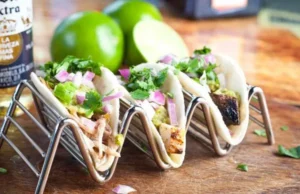Epazote (Dysphania ambrosioides) is a herb native to Central America, notably used in Mexican cuisine. It stands out from other herbs due to its unique flavor profile and distinctive appearance.
Epazote is pronounced “eh-pah-ZOH-teh.”
Epazote is considered essential in Mexican cooking due to its strong flavor and traditional use in various dishes, particularly those featuring beans and soups.
Varieties and Availability of Epazote:
Varieties: There is typically one primary species of epazote used in Mexican cooking, Dysphania ambrosioides. Different cultivars may exist, but variations in flavor or usage are not widely recognized.
Availability Outside Mexico: Epazote might be less commonly found outside Mexico compared to within the country. However, it is available in some Latin American or specialty grocery stores. In regions with a sizable Latin American community, it might be more accessible.
Sourcing Epazote: Epazote might be sourced fresh, dried, or in the form of seeds for cultivation. It’s occasionally available in dried form in international food sections of supermarkets or from online specialty spice retailers.
Flavor Profile and Aroma:
- Taste: Epazote has a strong, pungent, and somewhat medicinal taste with citrusy, minty, and earthy undertones. Its flavor is quite assertive, making it a characteristic herb in Mexican cuisine.
- Aroma: The aroma of fresh epazote is herbal, slightly pungent, and reminiscent of citrus and mint, making it easily recognizable in dishes.
Unique Flavor Contribution in Dishes:
- Beans and Soups: Epazote is known for its ability to reduce the gassiness in beans and adds a distinctive taste to bean dishes like frijoles de la olla (pot beans) or black bean soup. It complements the earthy flavors of beans while enhancing the overall taste of the dish.
Traditional Mexican Recipes Featuring Epazote:
- Frijoles de la Olla: This traditional Mexican bean dish often features epazote, contributing its flavor and aiding in digestion, making the beans easier to digest.
- Sopa de Lima: Some regional versions of this Mexican soup include epazote, adding a unique flavor to the soup made with chicken, lime, and spices.
- Pozole: Some variations of pozole, a traditional Mexican soup or stew, use epazote in the broth, adding its distinct taste to the hearty dish made with hominy and meat. Epazote is believed to have digestive properties, reducing the gassiness often associated with bean consumption.
- Culinary Versatility: Its strong flavor makes it an integral part of certain dishes, especially those with beans and soups, where it contributes its characteristic taste and aroma, enhancing the overall culinary experience.
Epazote’s unique flavor and traditional association with bean dishes and soups make it an indispensable herb in Mexican cooking, contributing to the authenticity and distinctiveness of various Mexican recipes.
Utilization of Epazote in Mexican Recipes:
Usage in Mexican Cooking: Epazote is primarily used in Mexican cuisine to flavor bean dishes and soups. It is added during cooking to infuse its distinct flavor into the dishes.
Specific Dishes Featuring Epazote:
- Frijoles de la Olla: This dish of simmered pot beans often includes epazote to enhance flavor and reduce gas-producing properties.
- Pozole: Some variations of pozole, a traditional Mexican soup or stew, incorporate epazote into the broth for its aromatic and flavor-enhancing qualities.
- Sopa de Lima: In certain regional versions of this Mexican soup, epazote is used to infuse a unique taste into the chicken and lime-based soup.
Recommended Pairings with Epazote:
- Beans and Legumes: It pairs exceptionally well with beans, lentils, and other legumes, complementing their flavors and reducing potential digestive issues.
- Spices and Herbs: Combine it with other Mexican spices like cumin, chili powder, or coriander to create robust flavor profiles in dishes.
Harvesting and Preparation of Epazote:
Harvesting Epazote: Epazote can be harvested by cutting the leaves and stems. Harvest young leaves for a milder flavor, while older leaves tend to have a more pronounced taste.
Preparation for Culinary Use: Before using epazote in cooking, rinse the leaves thoroughly and pat them dry. The leaves can then be finely chopped or added whole to dishes, allowing their flavor to infuse during cooking.
Drying and Preservation of Epazote:
Drying Methods: To dry epazote, tie the stems together and hang them upside down in a well-ventilated area away from direct sunlight. Once fully dried, remove the leaves from the stems and store them in an airtight container.
Preserving Flavor and Potency: To maintain epazote’s flavor and potency, store dried leaves in a cool, dark place away from heat and moisture. Using dried epazote within a reasonable timeframe helps retain its optimal flavor.
Properly dried and stored epazote can preserve its flavor for several months, allowing you to use it in various recipes to infuse that distinctive taste into your dishes.
Nutritional Value and Health Benefits of Epazote:
Nutritional Elements: Epazote contains vitamins A and C, calcium, iron, potassium, and various antioxidants, albeit in smaller amounts. However, its consumption in typical culinary use is usually in limited quantities.
Potential Health Benefits:
- Digestive Aid: Epazote is traditionally believed to aid digestion and reduce gassiness in bean dishes due to its carminative properties, potentially easing discomfort associated with bean consumption.
- Antimicrobial Effects: Some studies suggest that epazote may possess antimicrobial properties, potentially aiding in combating certain microbial infections. However, further research is needed to substantiate these claims.
Epazote’s Role in a Healthy Diet and Medicinal Uses:
- Digestive Health: In Mexican culture, epazote has been historically used to minimize digestive discomfort and bloating often associated with consuming beans. It’s believed to help break down complex sugars present in beans, making them easier to digest.
- Culinary Usage for Health: In Mexican cuisine, the inclusion of epazote in bean dishes aligns with the cultural belief that it aids in digestion and reduces the flatulence often linked to bean consumption.
Role of Epazote in Mexican Culinary Traditions:
Cultural Significance: Epazote holds significant importance in Mexican culinary traditions:
- Traditional Ingredient: It is regarded as a key herb in Mexican cooking, especially in dishes containing beans and soups, where it contributes a unique flavor and aids in digestion.
- Digestive Properties: Its use in bean dishes aligns with the cultural belief that epazote helps reduce flatulence and digestive discomfort associated with bean consumption.
Historical Anecdotes and Cultural Stories:
While specific historical anecdotes about epazote might not be extensively documented, its culinary use has been deeply rooted in Mexican cuisine for generations.
Epazote’s inclusion in cooking is more likely tied to indigenous culinary practices, where it was used not just for flavor but also for its purported medicinal properties, especially for aiding digestion.
Tips for Cooking with Epazote:
- Incorporating Epazote:
- Add fresh or dried epazote leaves directly to soups, stews, or bean dishes during cooking to infuse its flavor into the dish.
- For fresh epazote, finely chop the leaves before adding them to the dish.
- Quantity Guidelines:
- The amount of epazote used can vary based on personal taste preferences and the specific recipe. Start with a small amount and adjust to suit your flavor preferences.
- Roughly, for every cup of beans or soup, a tablespoon of fresh chopped epazote or a teaspoon of dried epazote can be a starting point, but this can be adjusted according to taste.
- Timing for Optimal Flavor:
- For dishes with longer cooking times, add epazote at the beginning to allow its flavors to infuse fully.
- In quick-cooking dishes like salsas or guacamole, add it towards the end to retain its fresh flavor and aroma.
Epazote’s Versatility in Cooking:
Epazote can be used in a variety of ways, but its predominant role is in flavoring bean dishes and soups. Its strong, assertive taste and reputed digestive properties make it a staple herb in Mexican cooking, enriching the authenticity and flavors of traditional Mexican recipes. Adjusting the quantity and timing of adding epazote can help achieve the desired taste and aroma in different dishes.





